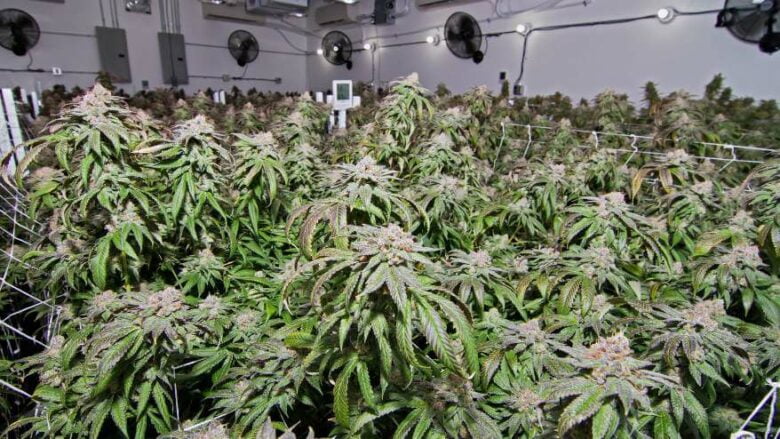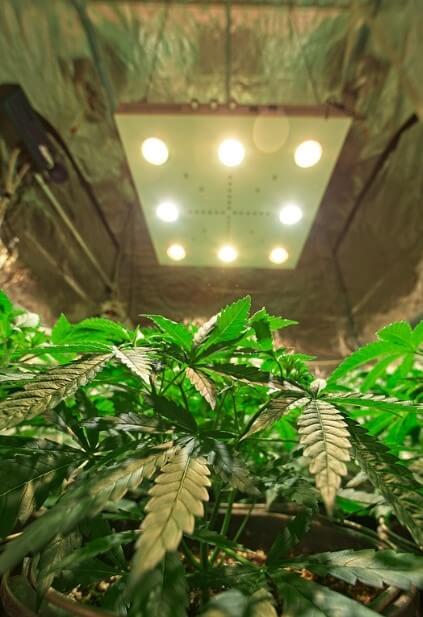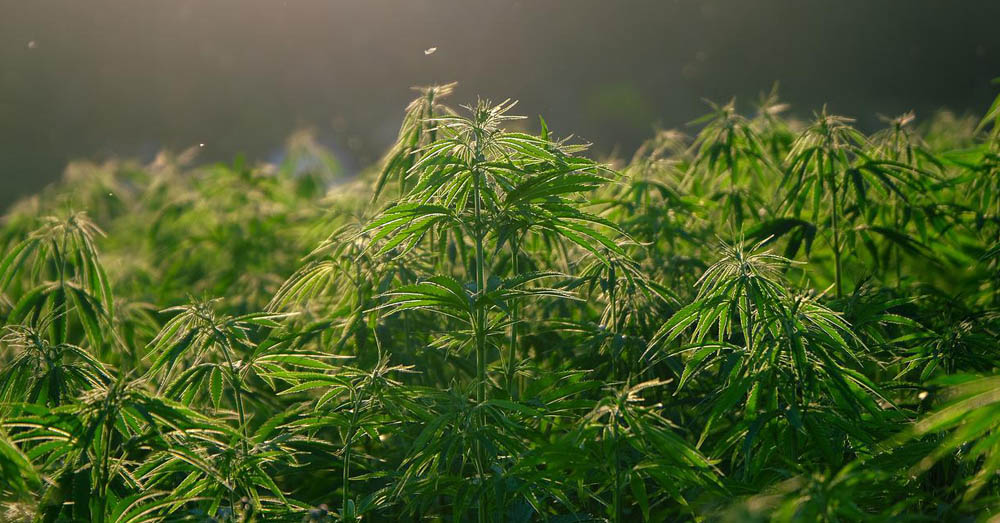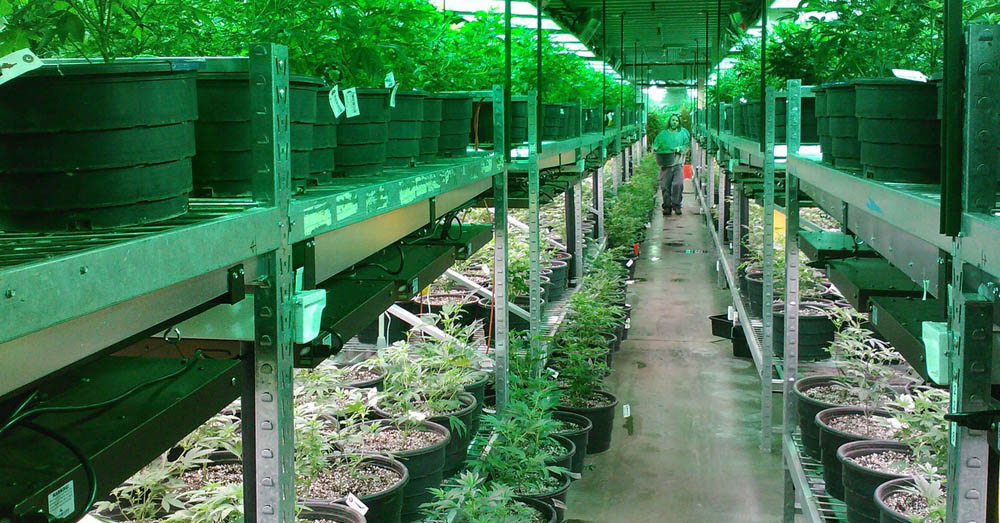The use of a reflective surface in indoor grow spaces maximizes light exposure and supports great weed yields. But which type of surface will help your cannabis plants reach their full potential?
This article will explore the best reflective materials for your grow tent. These should help your indoor cannabis make the most of its limited light sources.
Keep reading for all the information!
7 Best Reflective Materials for Growing Cannabis Indoors

There are many useful reflective materials for cultivating weed indoors.
If you are looking for the best grow tents for cannabis, we have a comprehensive article in the link.
For now, here are 7 reflective materials options worth looking into for use inside your grow tent:
1) Aluminium Foil
Aluminium foil is a super easy solution to create a light reflection in indoor cannabis grow tents because the vast majority of people already have this highly reflective film material in their homes.
Note that it is not the best reflective material in this list as it offers only around 55% – 65% light reflection. However, this is the perfect material if you’re a beginner looking to try light reflection out.
Cheap and readily available, aluminium foil can show you how effective it is for cannabis plants’ yields when you complement your use of grow lights with some reflective lining.
You can duct tape it to the walls of grow rooms, though remember that it is made of delicate material and tears easily. Also, the shiny side is MORE reflective than the dull side!

PROS
- Cheap
- Accessible
- Great for beginners

CONS
- Fragile
- Not for reflecting light long-term
2) Emergency Blankets
We bet you didn’t think this material that helps keep injured hikers alive by conserving body heat would be on the list! It turns out a few emergency blankets can help with growing weed.
Like the aluminum foil solution, however, it is not the best reflective material. It is actually partly made of Mylar (more information below), which provides 60% – 70% light reflectivity!
It is another cost-effective option for those who want to apply this treatment to their grow rooms. It might even be free if you choose to repurpose emergency blankets from your outdoor kit.
You can attach it to the walls of your grow space with double-sided adhesive strips. Keep in mind that it is also fragile and prone to creasing (which you do not want in your grow tent).

PROS
- Cheap
- Effective
- Good for covering small spaces

CONS
- Delicate
- Also Not a long-term solution
3) Mylar Film
Mylar is probably the most popular material many growers use to maximize reflected light in their grow rooms. This is because Mylar is a fairly cheap and HIGHLY reflective material.
Mylar is very efficient at its job, reflecting light in the 90% – 95% range back to the cannabis plants when you cover your grow tents’ walls with it. It’s no wonder many indoor gardens use Mylar.
Available in 1mm and 2mm thicknesses, Mylar is great for big grow rooms as it comes in large sheets. Of the two materials, the 2mm Mylar is superior in both sturdiness and longevity.
Its downside is that it is also quite fragile and prone to creasing, though not as much as aluminum foil or an emergency blanket. It is an excellent choice for pros and newbies alike!

PROS
- Highly reflective
- Relatively cheap
- 2mm is quite dependable

CONS
- It can still tear and crease with pressure
4) Orca Film
The Orca film is probably the most durable reflective material on the list. It has one black side and one white side, containing highly reflective microfibers that are great for growing weed.
This microfiber content makes orca film great at bouncing light to indoor cannabis plants AND long-lasting. Similar to Mylar, it can reflect 90% up to 95% of light.
More advantages of the Orca film are that it is easier to clean and more mold-resistant. Remember to face the white part toward the plants to get its reflective benefits.
One major downside is that the Orca film is very expensive. This might be better for growers with bigger operations than a casual grower who works with a small, personal grow room.

PROS
- Highly reflective
- Dependable and long-lasting
- Easy to clean

CONS
- Costly
5) Panda Film
The Panda film looks quite like the Orca film, with one side that is black and another that is white. However, it does not have the microfiber materials the other one contains.
Therefore, it is not as reflective but still very efficient, with the capability of reflecting 85% to 95% of light. The Panda film is a great option to cover the walls of your grow room with.
The Panda film is also quite popular with growers because it offers great light reflectivity and durability at a cheaper price point. Additionally, it is easy to clean and install.
You can use adhesives or a staple gun to mount the Panda film in place, and the artificial source which emits light can have its effects complemented and maximized for the plants to enjoy.

PROS
- Highly reflective
- Cheaper than Orca
- Reliable

CONS
- Still relatively expensive compared to Mylar
6) Foylon Film
Like the Orca and Panda film reflective materials, Foylon is also quite similar to Mylar. Many think of it as the slightly more expensive yet more durable version of Mylar.
We recommend Foylon to someone with a grow room who’s looking to get a slight upgrade from Mylar. It is also highly reflective and bounces up to 95% of light.
What makes Foylon more sturdy than Mylar is that manufacturers create it with rip-stop fibers. It is more crease-resistant, long-lasting, and easier to clean than Mylar.
That said, it is more expensive than Mylar, but the cost is worth it based on our experience. It also comes in large sheets, so you can cover the walls of your grow tent with it quite easily.

PROS
- Stronger than Mylar
- Easy to clean
- It does not crease easily

CONS
- Slight more expensive than Mylar
7) White Paint
Finally, if you are growing cannabis in a huge grow room and are due to upgrade your walls, white paint is something you should consider, as it is one of the most reflective materials for bouncing light.
By using flat white paint on your grow room wall, your plants can enjoy a durable (bordering on permanent) and easily well-maintained way to get the benefits of light reflection.
Flat white paint on your wall can reflect anywhere from 80% to 90% of light energy to your plants. This reflective material also does not take any special skills to be able to install.
This material also absorbs heat, so it’s an excellent choice for those whose houses are prone to hot spots. Remember that glossy white paint will not reflect as much light, so try to avoid that.

PROS
- A great option for long-term
- Simple application
- Highly reflective

CONS
- Not the cheapest for big spaces
Things You Shouldn’t Use as Reflective Materials
Not every reflective material should be used in a grow room. Here are some no-nos:
Mirrors
We do not recommend using a mirror as a reflective material for cultivating cannabis in a grow room for several reasons.
The first of which is that it can generate heat. Though it is reflective of light, it also traps heat which can cause the temperature to rise at a particular spot and harm your plants.
It also offers poor reflectivity. You’re better off using Mylar or the other options above that provide more even reflection and are less likely to cause hot spots.
Additionally, mirrors are expensive and hard to maintain. They need to be cleaned regularly to maintain their reflective qualities.
Other materials, on the other hand, only need to be wiped down every once in a while with something as simple as isopropyl alcohol, for example.
Styrofoam
Though film sets use styrofoam as a reflective material, it is not great for growing pot.
Like mirrors, it has low reflectivity and will not work as efficiently as materials made for grow spaces, potentially reducing your plants’ growth and yields.In addition, it is a fire hazard. Styrofoam is a highly flammable material that can easily catch fire. This serious risk is not worth taking for what little it can do.
3 Tips for Using Reflective Material in a Grow Room
Here are three of the most impactful tips we have for you:
- Avoid creases: Install materials securely and evenly throughout the grow tent to ensure maximum reflection. This will help you avoid hotspots and uneven reflections.
- Clean them regularly: Your materials can get dirty over time, reducing their effectiveness, and can even introduce molds to your space!
- Cover other surfaces: Doors, windows, etc., should also get light-reflecting treatment so you can fully maximize their benefits.
In indoor settings, light (whether natural or artificial) is limited, but weed needs a lot of it. Follow these tips to get the most light for them as possible without needing to leave the outside.Aside from light, did you know that temperature plays a big role in your plant’s yield? Check out our guides on how to cool your grow tent and the best grow tent heaters for more information.
Is a Reflective Material Essential for Indoor Cannabis Growth?

Reflective material is not essential for cultivating cannabis indoors, but it can be beneficial.
Unfortunately, the light emitted from grow lamps results in a lot of wasted light (specifically from the middle portion of the lightwave), which plants could use for more energy.
Reflective materials help maximize the amount of light that reaches the plants, leading to increased growth and yields.
Growing any plant indoors limits the light resource available, so any help to focus and gather more of it would be appreciated, especially by certain cannabis strains.
Ultimately, whether or not a reflective material is essential for indoor cannabis growth will depend on your specific setup and growing conditions.To best help your cannabis growth, check out how to control humidity in a grow tent and our article on the best humidifier for your grow tent.
Frequently Asked Questions (FAQs)
Here we answer some common questions about the best reflective materials for your grow tent:
What is the Best Light Reflective Material?
The best reflective material for you will depend on your situation, though a solution that seems to work pretty well across the board is Mylar.
Mylar reflects light very well and is affordable and easy to use. However, you might want to stay away if you have a heavy hand and find it difficult to apply delicate materials.
If you want something more sturdy and stable, try working with Foylon, Orca, or Panda films instead. These can be as reflective of light as Mylar and are easier to handle and clean.
Does Aluminum Foil Reflect Grow Lights?
Yes, aluminum foil can reflect light waves from a grow light! Again, it is not as efficient as Mylar or other such materials, but it is easily accessible, and it works (which is the most important part).
If you want to start doing light reflections on your grow spaces and would rather not wait for special items to be shipped, we recommend giving it a shot! It’s a good way to explore reflective surfaces.
Can I Use Mirrors To Reflect Light In My Grow Room?
We do not recommend the use of mirrors for this purpose for the reasons listed above.
As a quick recap, remember that it is not as reflective as materials like Mylar and can make grow spaces detrimentally hotter. Mirrors are also expensive and have poor ease of use.
Conclusion: What’s the Best Reflective Material for a Grow Room?
The best reflective materials for the indoor growth of weed include Mylar, Foylon, Orca films, Panda films, white paint, aluminum foil, and even an emergency blanket!
They are efficiently able to maximize the limited light sources in an indoor grow space environment, while things like mirrors and styrofoam should be avoided.
Ultimately, the best one depends on your cannabis strain needs and how much you can spend on your set-up.




